
2024 ORDER MANAGEMENT TRENDS REPORT
Do Retailers and Grocers Have The Tools They Need?
The 2024 Order Management Trends Survey
In an increasingly digital order management ecosystem, there’s no in-between — how your business tracks and controls inventory is either a liability or an advantage.
Modern tooling plays an essential role for retailers and grocers in making sure an order management system (OMS) gives them the upper hand. This includes critical functions like order routing and inventory management.
But do the current tools offer the most cutting edge, advanced order management capabilities at a reasonable cost, with as much speed and flexibility as possible?
As retail margins face continued pressure and customer fulfillment expectations increase, competitive retailers and grocers must ensure they’re getting a strategic advantage from their technology.
Nextuple partnered with Retail Dive’s studioID to survey 302 executives in the retail and grocery spaces to better understand the state of order management tooling. In this report, we’ll highlight important findings from the survey as a whole, and also break the data down by industry, revenue, function and job level.
We’ll also explore these three key themes that emerged in the data:
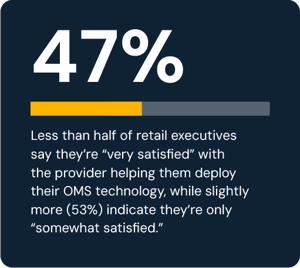
While respondents say they’re satisfied to some degree with current OMS vendors, when pressed for details of what they are investing in, they indicate current offerings from major industry players are missing capabilities, have a high cost of ownership, and may not be as flexible architecturally as they desire.
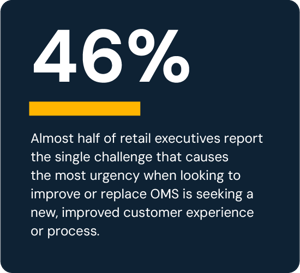
Retailers believe new experiences are the key to success, and they’re laser-focused on providing those experiences as part of their growth strategies. However, it appears the speed and flexibility of these new experiences is too closely tied to major upgrades from legacy OMS provider platforms.
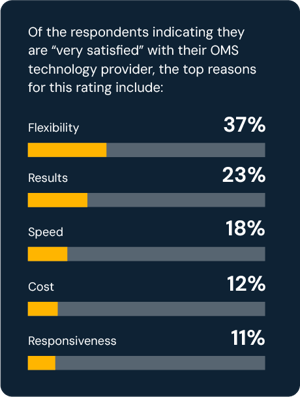
Retailers seek new and needed functionality, but they seem to overlook (or be too risk averse to embrace) their ability to leverage specialty providers and niche implementers that have quietly been bolstering big names in the industry.
By understanding the state of order management heading into 2024, retail and grocery executives will be able to more clearly perceive the limitations of their current technology providers and secure support that allows them to pursue the most urgent areas of improvement in the months to come.
About the Research
This research is based on an online survey conducted by Retail Dive’s studioID on behalf of Nextuple in the fall of 2023. A total of 302 executives within retail-type organizations participated in the research.
Most participating organizations report annual revenues of $500 million or more
Annual Revenue
% of Participants
$250 million to $449 million
6
$500 million to $999 million
67
$1 billion to $49 billion
26
$50 billion or more
1
Participating executives most often work in IT
Job Function
% of Participants
IT
70
Retail operations
11
Ecommerce
10
Supply chain operations
4
Product management
3
Omnichannel programs
2
All participants play a key role in technology decisions for their company’s omnichannel OMS
Role in OMS Technology Decisions
% of Participants
Yes, I am the decision-maker
65
Yes, I am part of a group of decision-makers
35
Most participants fall into two levels of executive functions
Title
% of Participants
Director
57
EVP, SVP, VP
37
C-Suite
8
Qualified participants describe their primary industry as follows
Primary Industry
% of Participants
Grocery
43
Retail
42
B2B Retail
15
The State of Order Management in 2024
The survey provides insights into potential shifts grocers and retailers may make as they assess how their OMS will assist in achieving their goals. For example, almost all retail executives say they’ll likely use their current supplier when they next upgrade their OMS. Nearly six in 10 executives (58%) say it’s “very likely,” and four in ten (40%) say it’s “somewhat likely,” citing reasons like speed of implementation, modern technology, flexibility, and competitive pricing or total cost of ownership.
However, we also surfaced many indications current OMS suppliers aren’t hitting the mark.
“If only 23% of those surveyed think their current vendor has modern technology, does that mean the rest possibly think they don’t, and they’re looking for something newer and better?” says Chap Achen, VP Product Strategy and Operations at Nextuple.
At times, the following findings revealed nuances between the overall survey respondents and survey respondents segmented out by the respondent’s industry, revenue, function, and job level. These nuances are noted accordingly.
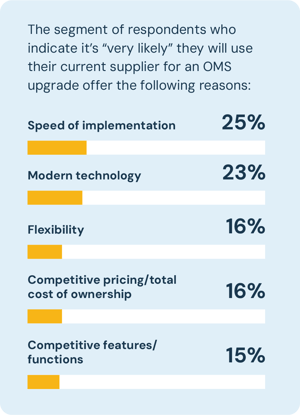
Nuances Among Respondents
- Here’s a look at the state of order management for the year ahead:
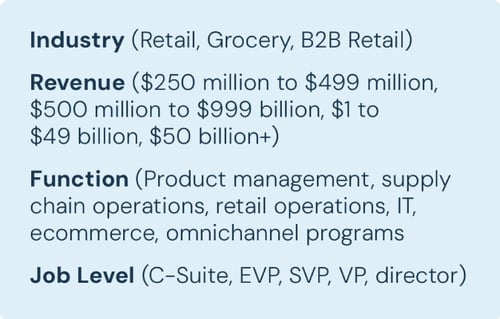
Platforms and Partners
According to the research, retailers and grocers use a significant number of order management system applications or solutions providers. Larger players like IBM, SAP, and Oracle hold 44% of the market, while other OMS providers make up the difference.
Respondents tend to rely on solution or platform expert services to deploy their OMS technology, with 69% saying they do so. However, it’s worth noting retailers (61%) are less likely to rely on solution/platform expert services than grocers (74%) or B2B retailers (72%), and almost all of the smallest retailers (95%) use solution/platform expert services. Interestingly, group decision-makers are particularly likely to use solution/platform expert services (77%), while lone decisionmakers are more likely than others to rely on a large global system integrator (20%).
Nearly half of retail executives (47%) say they are “very satisfied” with the provider helping them deploy their OMS technology, while slightly more (53%) indicate they are “somewhat satisfied.” Interestingly, only 5.6% of all respondents cite cost as one of the reasons they’re satisfied, which could indicate opportunities for lower-cost implementation service specialists and boutique partners. However, when asked why they’re looking to improve or replace OMS technology, 26% cite “avoiding current vendor limitations.” The results can be further broken out into top issues such as:
- Current solution licensing is too costly
- The OMS lacks key features
- Platform capabilities are outdated
Respondents who are “very satisfied” with their OMS technology provider offer a number of reasons, with no single answer dominating. Executives who are “very satisfied” say the top reason for this rating is flexibility (37%), results (23%), speed (18%), cost (12%), and responsiveness (11%). Overall, grocery executives (37%) and the smallest companies (16%) are the least likely to say they’re “very satisfied.”
When it comes to cloud providers, half of retail executives participating in this survey (53%) report currently using Amazon Web Services (AWS). Three in 10 (30%) use Google Cloud Platform (GCP), while 17% use Microsoft Azure. These numbers vary according to different demographics. However, B2B retailers are the most likely to use Amazon (66%), and grocers are least likely (46%).
Features and Functions
We also surveyed respondents about the features and functions of their OMS, inquiring about order promising, delivery data promising, order orchestration, and order fulfillment functions. The results indicate a lot of room for improvement for legacy OMS tools, specifically in filling gaps in their offerings.
In fact, when it comes to investing in OMS upgrades in the next six months, about four in 10 retail executives (43%) say they’re making the most investment in order orchestration. Meanwhile, three in 10 will invest in order promising (30%), and one in four (27%) will invest in order fulfillment.
Meanwhile, three in 10 will invest in order promising (30%), and one in four (27%) will invest in order fulfillment.
Organizations must be aware of smaller, more flexible OMS partners who bring solutions that fill in these gaps.
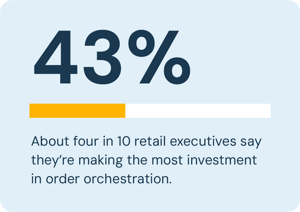
Order Promising
When considering upgrading the order promising functions of their current or legacy OMS in the next six to 18 months, executives are likely to be most interested in improving or replacing inventory accuracy and availability (72%) or sourcing optimization (70%) features. Over four in 10 (44%) would like to upgrade delivery date promises, and somewhat fewer (37%) would like to upgrade cost-to-serve optimization.
“It’s worth noting that inventory accuracy and availability and sourcing optimization features are the two main things an OMS can deliver real business value with,” says Chap Achen, Vice President of Product Strategy and Operations at Nextuple. “If a retailer or grocer wants to upgrade these features, it speaks to the fact they are not satisfied with key business drivers they purchased the OMS for in the first place. It would appear these legacy providers are not meeting the mark in this area.”
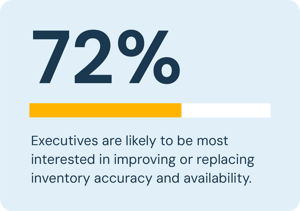
Delivery Data Promising
Among those most interested in improving delivery data promise, increased speed of delivery (47%) and accurate estimated delivery date (45%) are considered the most important aspects to upgrade. Very few respondents looking to improve delivery data promise say it’s to reduce cost to serve (8%). This may mean most retailers and grocers think of promising only in reference to their ability to show estimated delivery dates rather than being able to come up with a profitable promise — a missed opportunity that must be addressed.
Interestingly, for respondents in the B2B segment, delivery date promising scored higher than the other sub-industries at 55%, which suggests they might have additional promise date needs or deficiencies in their current tooling. Demographic differences also show the delivery data promise is of particular interest to the VP level (55%) and to decision-makers (51%), but of less concern to grocers (36%).
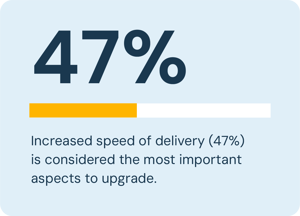
Order Orchestration
When considering the order orchestration functions of their current or legacy OMS, the majority of executives cite several features they would like to see improved. Two in three retail executives (68%) are most interested in improving or replacing order monitoring in the next 6 to 18 months. Six in 10 (60%) cite order workflow management, while half (52%) mention order modifications as functions requiring improvement. Four in 10 (43%) would like to see order repository/cache improved or replaced, and one in four (26%) mentions customer communications.
Interest around order orchestration functions fluctuates by different demographic segments. For example, B2B retailers are particularly interested in improving order monitoring (79%) and order workflow management (75%), while grocers are less likely than others to cite order workflow management (49%) and order repository/cache (33%).
Further fluctuations include:
- Interest in improving order monitoring declines with company size.
- Mid-sized companies – with revenues from $500 million to $999 million – are the most interested in improving order repository/cache (49%).
- VP-level retailers are the most likely to cite improvements in order repository (53%).
- Lone decision-makers are more interested in improving order workflow management (69%) and order repository (50%) than others.
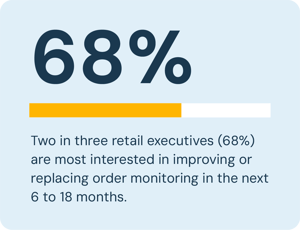
Order Fulfillment
When considering the order fulfillment functions of their current/legacy OMS, about half of respondents cite three features they are most interested in improving. Fifty-six percent of retail executives say they would like to improve or replace the pick execution feature of their current OMS. Exactly half mention customer pickup, and 48% mention pick planning (48%). Meanwhile, 41% seek improvement/replacement in same day delivery and 40% seek improvement/replacement in packaging and shipping
Demographic differences emerge with the order fulfillment function, as well:
- B2B retailers are the most likely to choose pick planning (66%).
- Grocers are less likely to name same-day delivery (30%), customer pickup (39%), and pick planning (40%) than others.
- Mid-sized companies are most interested in improving customer pickup (55%).
- The smallest enterprises are the least interested in improving pick planning.
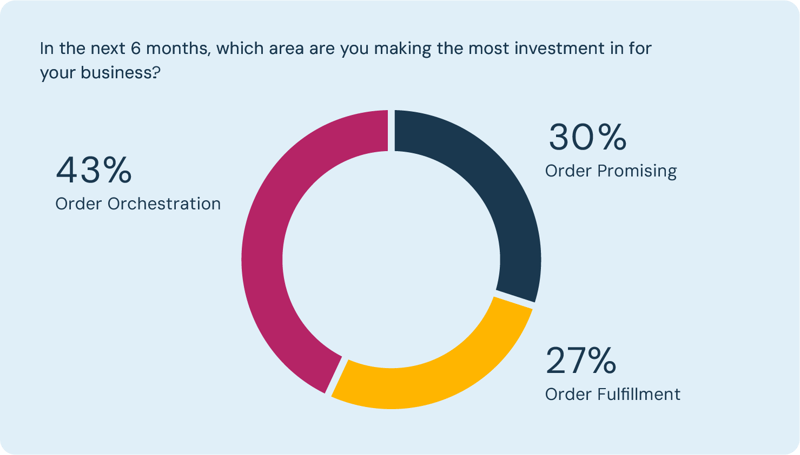
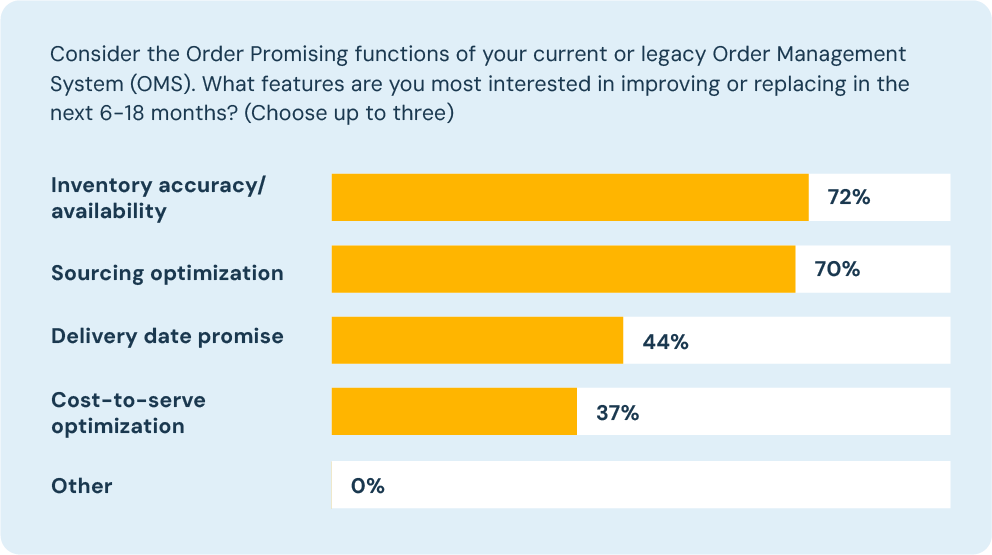
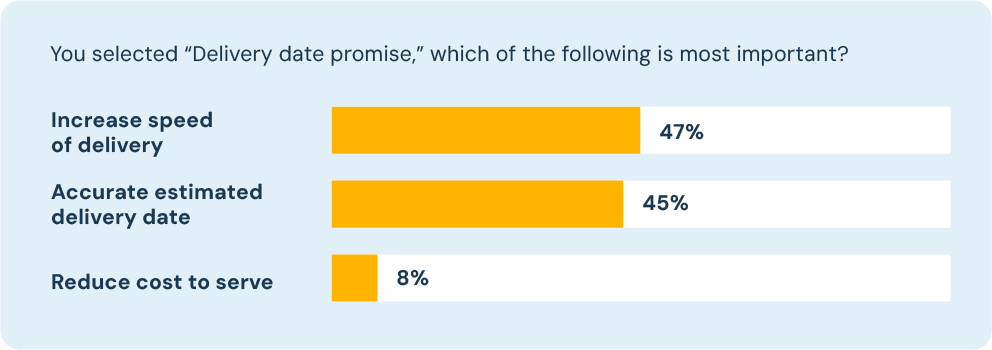
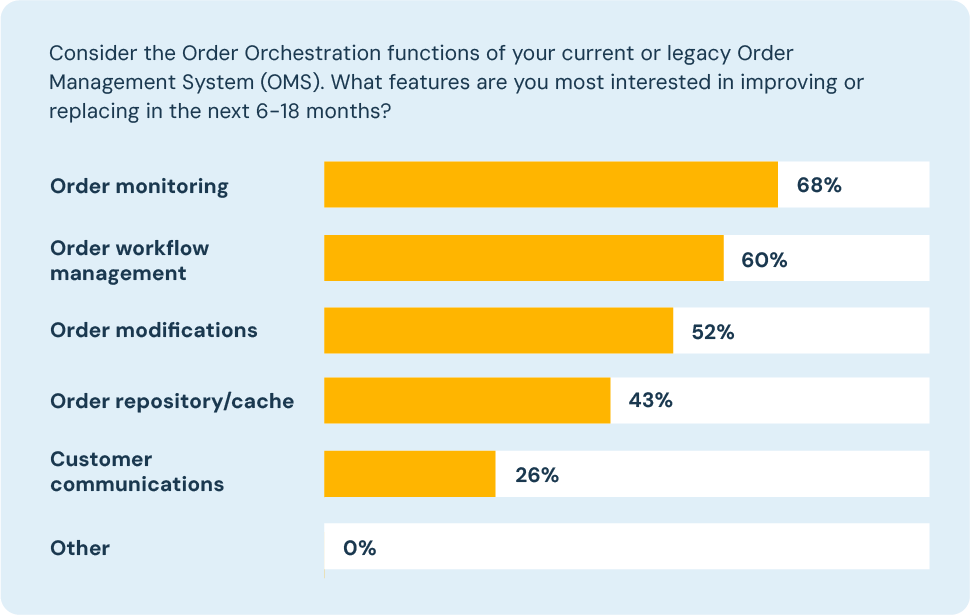
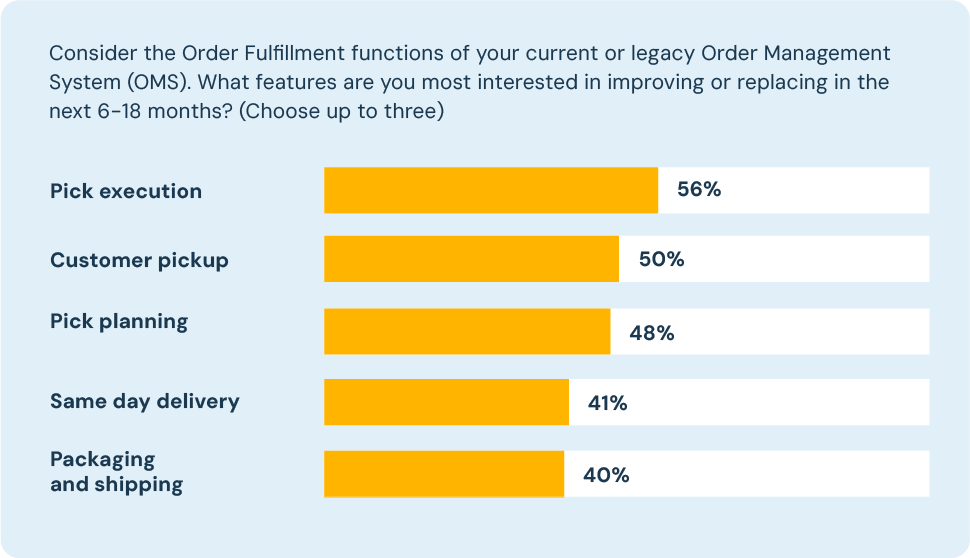
Challenges and Priorities
Retailers and grocers that want to thrive must constantly push to meet ever-changing customer demands with shifting inventory availability. They must also balance these challenges with the unique priorities every organization brings to the table. The following sections highlight the current state of challenges and priorities among stakeholders today.
Challenges
Improving customer experience is most often considered the single biggest challenge when improving/replacing an OMS. Almost half of retail executives (46%) report that the most urgent challenge is seeking a new, improved customer experience or process. Other significant challenges include cost cutting (27%), competitive pressure (27%), avoiding current vendor limitations (19%), and eliminating or reducing SaaS license costs.
These overarching challenges can be further broken down into limitations and areas in need of improvement.
For example, among those who consider “seeking a new improved customer experience/ process” the most urgent challenge, 37% say accurate delivery promising is the top reason for this choice. One in four (25%) cite better customer communications as the top reason, and roughly one in 10 cite the following reasons for their choice:
- Improved store fulfillment (10%)
- Better pickup experience (10%)
- Same-day delivery (9%)
- Better returns (7%)
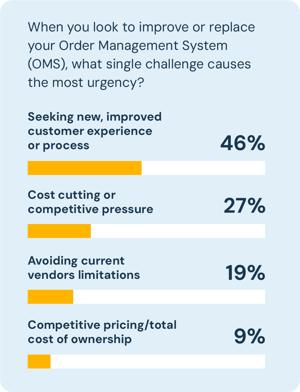
Furthermore, among those who consider “cost cutting or competitive pressure” the most urgent challenge, 64% say finding more efficiency in store fulfillment is the top reason for this selection. Other reasons include the need to reduce shipping costs (56%), increase online sales by leveraging store inventory (49%), reduce customer contacts (32%), and a need for competitive parity (15%).
Among those who consider “avoiding current vendor limitations” the most urgent challenge, 37% list current solution licensing being too costly as the top reason for their choice. Other reasons include a lack of key features capabilities (28%), outdated platform/capabilities (25%), and limited support/implementation/customization (11%).
However, it’s important to keep in mind some variations in responses based on demographic segments. Retailers (28%) and lone decisionmakers (24%) are more concerned than others with avoiding current vendor limitations, and B2B retailers are more concerned with cost cutting (36%) and less concerned with avoiding current vendor limitations (9%).
Priorities
When it comes to upgrading an organization’s OMS, retailers and grocers are most motivated by speed of implementation (69%). Speed of implementation is of particular concern to retailers (77%).
Other priorities include features and functions (61%), total cost of ownership (48%), and future agility and flexibility (42%). However, it’s worth noting future agility concerns grocers (46%) and group decision-makers (58%) more than others.
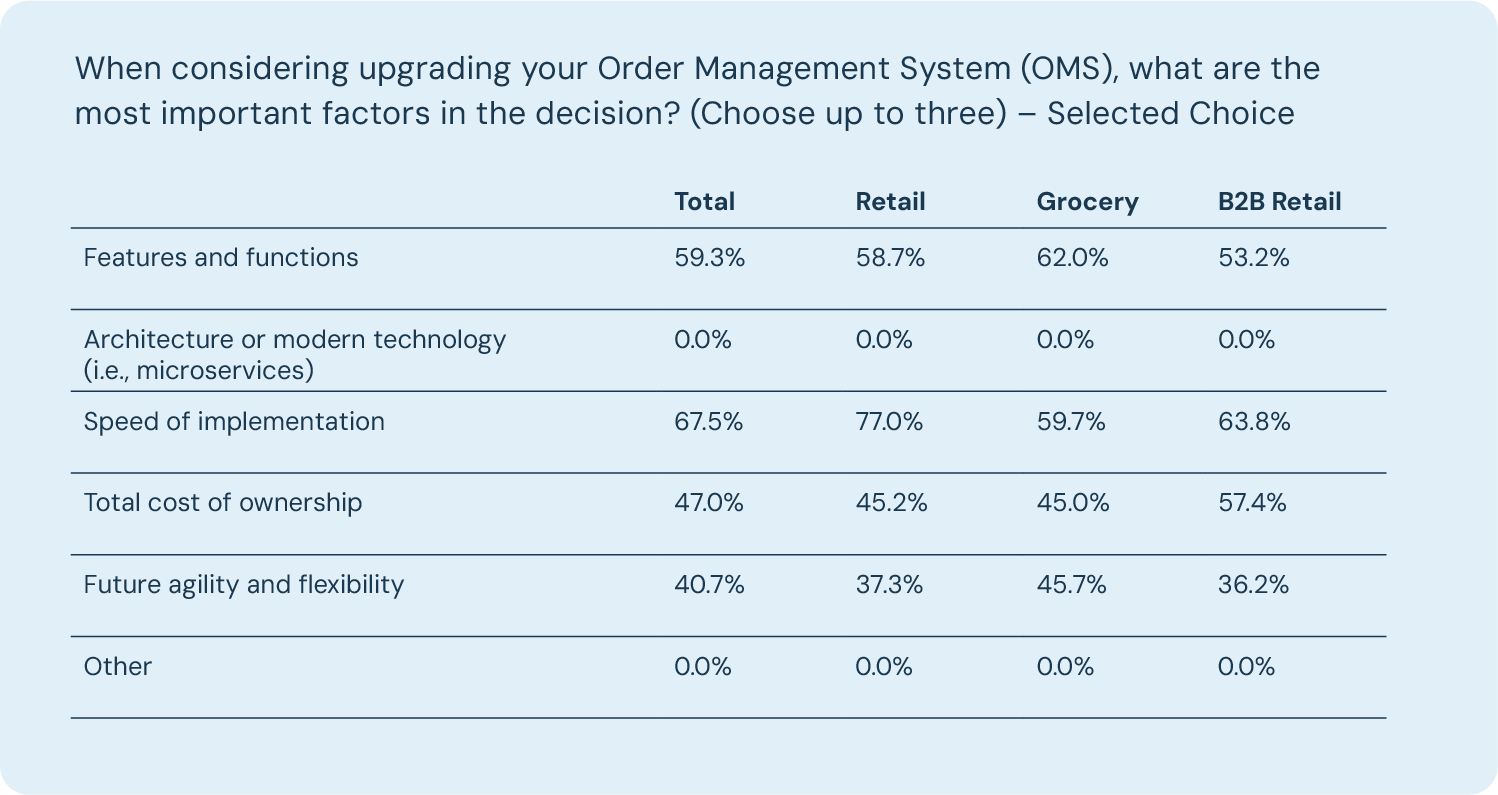
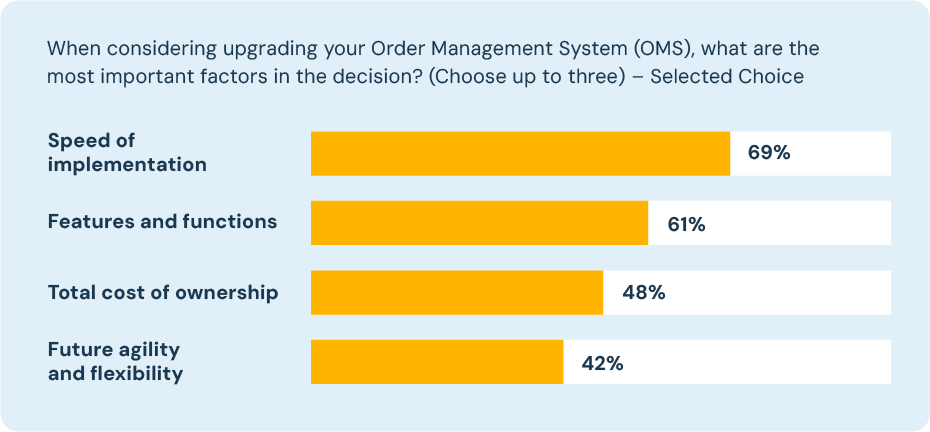
Planning for the Future
A retailer and grocer’s interaction with an OMS can greatly affect their ability to bring their vision to life. We asked respondents about the trends they found most intriguing for the coming year. They responded with a range of interests, including:
OMS Trends for 2024
An organization’s ability to leverage these trends depends on how quickly it can make decisions. To that end, the data reveals that organizations have significant variation in terms of who has the most influence in deciding to upgrade their OMS.
Half of retail executives (50%) say IT/ Engineering has the most influence in their companies’ decision to upgrade their OMS. About one in five say it’s Operations (22%) or Line of Business (18%), and one in 10 companies (10%) say the Digital Team has the most influence. Interestingly, when asked if they were the decision maker or part of a group of decision makers, 86% of the ecommerce-related titles answered they were the lone decision maker. That outpaces the 63% of IT titles who claimed to be the lone decision maker. So while IT may have the most influence industry-wide, ecommerce stakeholders are more likely to see themselves as having the power.
Looking Forward
A retailer or grocer’s OMS is a powerhouse of possibilities — but only if the organization has access to the latest, most flexible technology available.
Organizations limited by their OMS – whether for reasons of features, speed, or cost – simply won’t achieve their full potential and will leave too much opportunity on the table.
Businesses today face more than enough challenges from customer demands, supply chain issues, and labor limitations. Being held back by an OMS or technology partner shouldn’t be one of them. This report shows that, while satisfaction with current OMS providers is generally high, organizations are keenly aware of the challenges and the need for improvements in key areas.

Nextuple helps customer-centric retailers and grocers create and transform omnichannel fulfillment by using a microservices architecture. The Nextuple OMS Studio enables retailers to quickly build and scale new fulfillment experiences to delight customers, create more omnichannel agility, and accelerate time-tovalue. Nextuple has offices in Massachusetts, U.S., Ontario, Canada, and Bangalore, India.